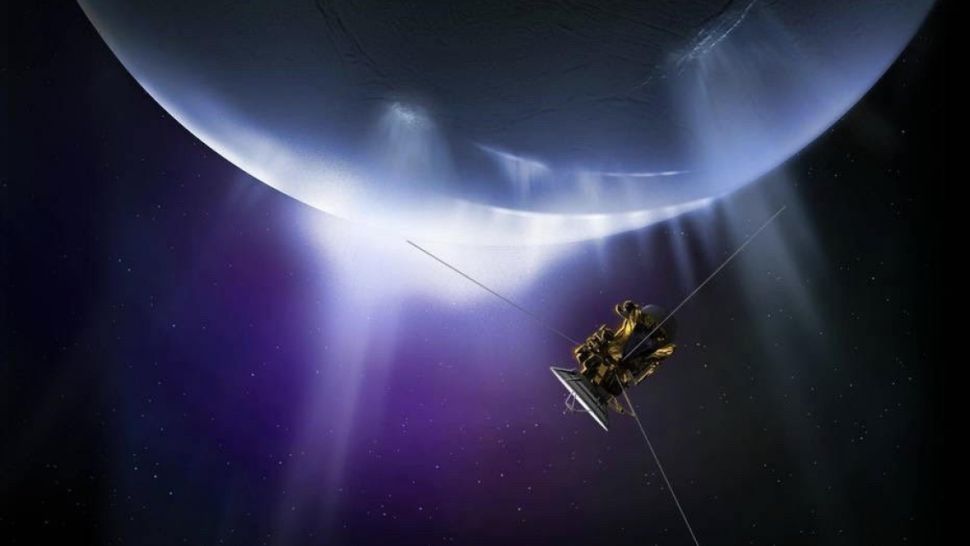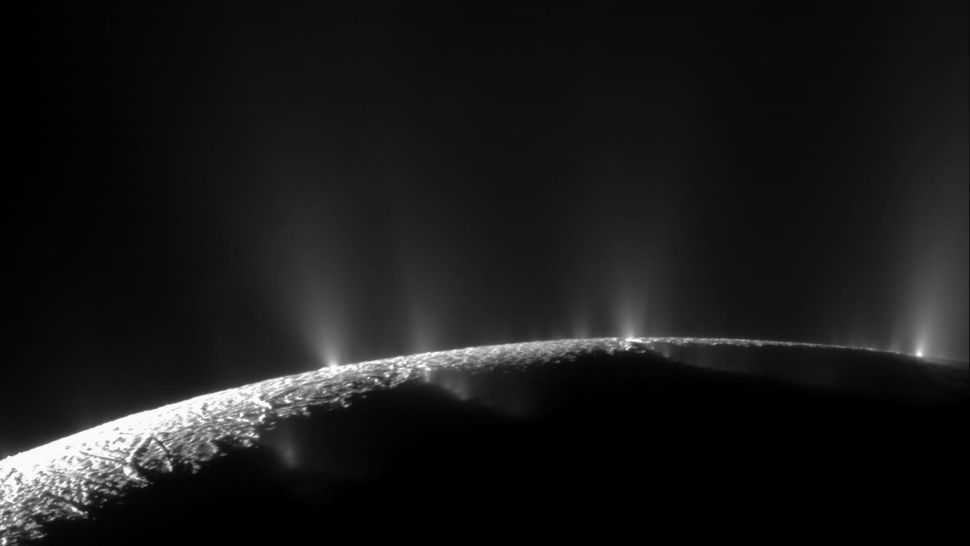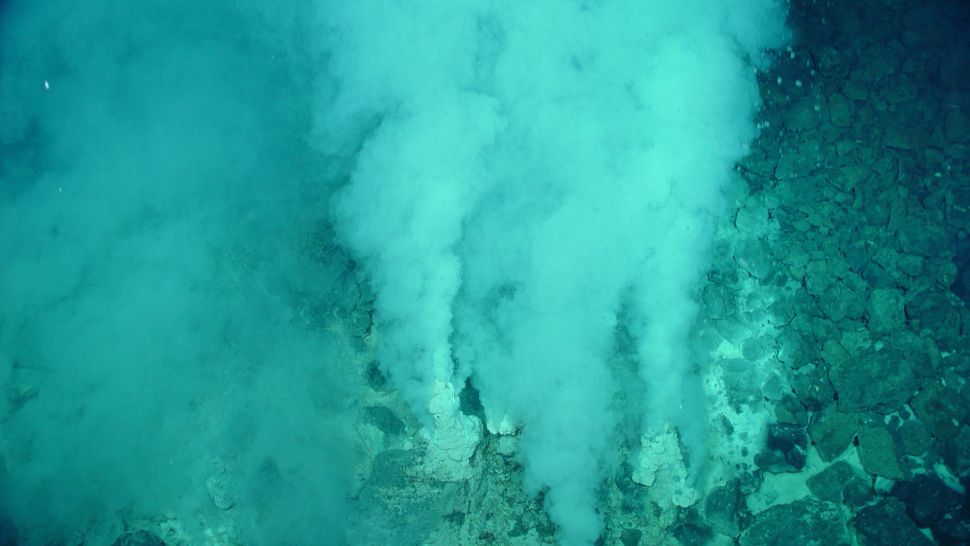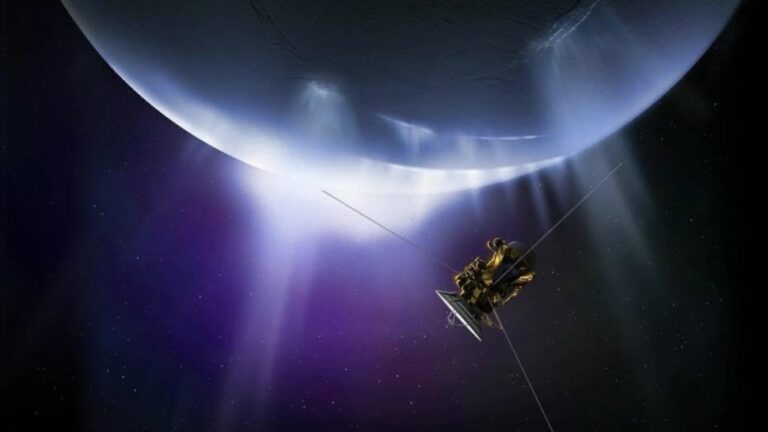According to a research, Enceladus’ geyser plume would need to be flown through 100 times in order to detect life there.
The giant water plumes of Saturn’s moon Enceladus offer a unique opportunity to seek life without landing.

According to recent study, it may be possible to find life on the icy moon Enceladus of Saturn without ever setting foot there. It wouldn’t be simple though.
A group of scientists discovered that it would take more than 100 flybys of Enceladus’ geyser plume by an orbiting spacecraft before a cell, a critical evidence of life, could be detected. In the event that life is not found, this discovery may be useful in planning future space missions to Saturn and Enceladus and in maximizing scientific results.
The NASA Cassini spacecraft passed across geysers that were erupting from Enceladus’ surface in 2015. The abundance of dihydrogen (H2) in the plume, as shown by data from several flybys, suggested the possibility of hydrothermal vents on the moon’s bottom, similar to those on Earth. The data also showed abundant levels of carbon dioxide and methane (CH4), both of which indicated the possibility of methane-based life forms called methanogens near Enceladus’ hydrothermal vents.
In order to better comprehend how many cells may infiltrate the plumes that eventually jet out from the moon’s surface, researchers have now recreated the hydrothermal vent environment on the moon to estimate the mass of such a methanogenic ecosystem.
The study’s primary author, Antonin Affholder, a postdoctoral research associate at the University of Arizona, said in a statement: “We were shocked to find that the potential abundance of cells would barely equate to the biomass of one solitary whale in Enceladus’ global ocean”
The scientists calculated cell densities and discovered that the biosphere, or area that supports life, near hydrothermal vents on the moon may be quite small – fewer than 10 tons of carbon, which is less than the biosphere on Earth.

However, this new research suggests that a sufficient quantity of methanogen cells and organic material would reach the plume, increasing the likelihood that at least part of them would be collected by a passing spacecraft.
The biology of Enceladus could be relatively little, according to Affholder. And yet, according to our simulations, it would be effective to add just enough organic molecules or cells to the plumes such that detectors on a future spacecraft might detect them.
Methanogens would live beside hydrothermal vents, like they do on Earth, if they are present on the bottom of Enceladus. At least 100 plumes actively shoot from fissures in the frozen crust as warm water produced at such vents, combined with cells of methanogens, ascend to the moon’s surface.

There are probably similar vents on the seabed of Enceladus. Tubeworms, yeti crabs, and a unique kind of shrimp with light-sensitive cells (or eyes) on its back may all thrive and develop in conditions near hydrothermal vents on Earth. Akin vents on Enceladus are intriguing locations to look for alien life because they are similar to the distinctive and diverse deep sea ecosystems seen near hydrothermal vents on Earth.
Researchers claim that sampling a cell from an orbiting spacecraft is feasible, assuming that the majority of the methane originates from methanogens that live deep below the moon’s ocean.
Flythrough sampling is a time-sensitive difficulty since prior studies suggested that 93% of the plume material falls back(opens in new tab) onto the moon’s surface. Furthermore, when the plume moves higher and outward into space, not every cell that enters it survives the pressure changes. Depressurization causes 94% of the cells to be killed, according to previous research.
The existence of inanimate objects termed organic abiotic amorphs poses a potentially more worrisome problem. According to the current study’s authors, abiotic amorphs have the same signatures as live cells, which increases the likelihood of false positive results.
Affholder’s team discovered that at least 0.1 mL of a plume must be sampled, which they believe is comparable to 100 spacecraft flythroughs, in order to overcome these difficulties and increase the likelihood of sampling a (actual) cell.
Although 100 flythroughs may seem like a lot, the Enceladus Orbilander mission’s present strategy demonstrates that it is feasible. Orbilander may do 1,000 flythroughs of the plume during the course of a year and a half of mooncircling. These samples would represent important evidence in the search for life on the moon, whether it exists or not.
According to Affholder, “the conclusive proof of living cells discovered on an extraterrestrial world may stay elusive for millennia.” “Until then, the most we can probably hope for is the fact that we cannot eliminate out life on Enceladus.”
The research is described in a paper published Dec. 13 in The Planetary Science Journal.
Do not forget to share your opinion with us to provide you with the best posts !




0 Comments